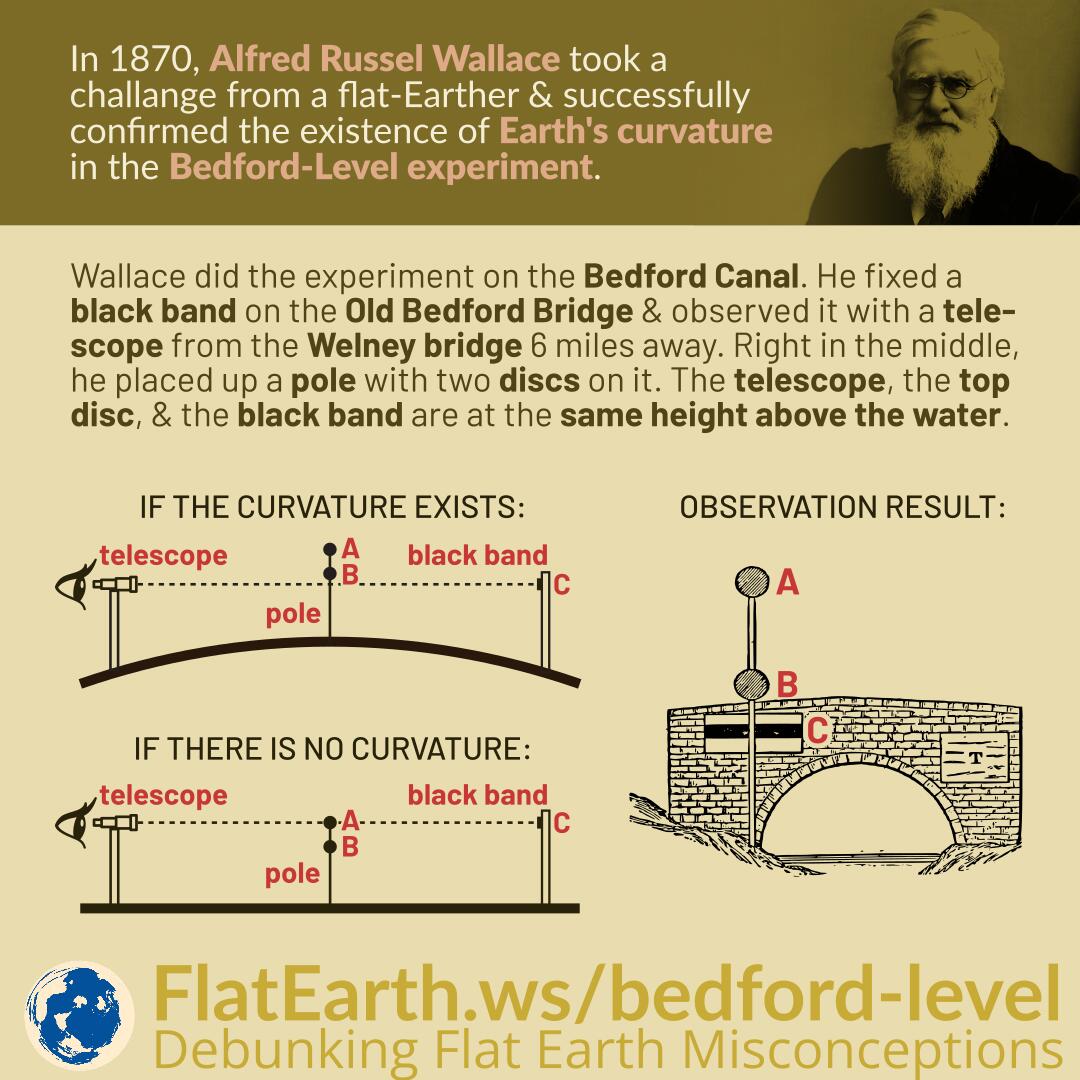In 1870, Alfred Russell Wallace took a challenge from a flat-Earther and successfully confirmed the existence of Earth’s curvature in the Bedford level experiment.
Wallace did the experiment on the Bedford Canal. Wallace fixed a black band on the Old Bedford Bridge and observed it with a telescope from the Welney Bridge 6 miles away. Right in the middle, he placed a pole with two discs on it. The telescope, the top disc, and the black band are at the same height above the water.
From the telescope, both discs were seen above the black band, proving the existence of Earth’s curvature.
Hampden, the flat-Earther, was a disciple of Rowbotham, who significantly influenced the flat-Earth movement back in the day. Rowbotham had previously used the Bedford Canal to prove the non-existence of Earth’s curvature. He looked through a telescope from one end of the canal and observed boats on the other end.
He ignored the effect of refraction and wrongly concluded that the Earth does not have curvature. Wallace designed a better experiment to minimize the effect of refraction:
- He raised the entire experiment by 13 ft 3 in (4 m) above water. In contrast, Rowbotham did his experiment only 8 in (20 cm) above water.
- He added a pole with two discs in the middle of the canal for observational aid. This way, if there’s a curvature, it would be easy to observe.
In the experiment, Wallace successfully proved the existence of Earth’s curvature. Unfortunately, Hampden, like many flat-Earthers, was not honest. He never had the intention to allow Wallace to take the wager. Instead, he made various threats to Wallace and his friends over the years and as a result, was put in jail many times.
Detailed Story
On January 12, 1870, John Hampden, a flat-Earther and a disciple of Samuel Rowbotham, wrote in Scientific Opinion magazine and challenged scientists to prove the existence of Earth’s curvature. He offered £500 as a reward for anyone who could prove it.
A cash-strapped Alfred Russel Wallace thought he would earn easy money. He answered the challenge and made the demonstration on the straight and 6-mile long Bedford River (9.7 km).
He is the same Alfred Wallace, a notable biologist and conducted various research in many places in the world.
Wallace, who had experience in surveying, designed his experiment as follows:
The Old Bedford bridge, about six miles off, was of brick and somewhat higher. On this bridge I fixed a large sheet of white calico, six feet long and three feet deep, with a thick black band along the centre, the lower edge of which was the same height from the water as the parapet of Welney bridge; so that the centre of it would be as high as the line of sight of the large six-inch telescope I had brought with me.
At the centre point, about three miles from each bridge, I fixed up a long pole with two red discs on it, the upper one having its centre the same height above the water as the centre of the black band and of the telescope, while the second disc was four feet lower down.
It is evident that if the surface of the water is a perfectly straight line for the six miles, then the three objects—the telescope, the top disc, and the black band—being all exactly the same height above the water, the disc would be seen in the telescope projected upon the black band;
whereas, if the six-mile surface of the water is convexly curved, then the top disc would appear to be decidedly higher than the black band, the amount due to the known size of the earth being five feet eight inches, which amount will be reduced a little by refraction to perhaps about five feet.
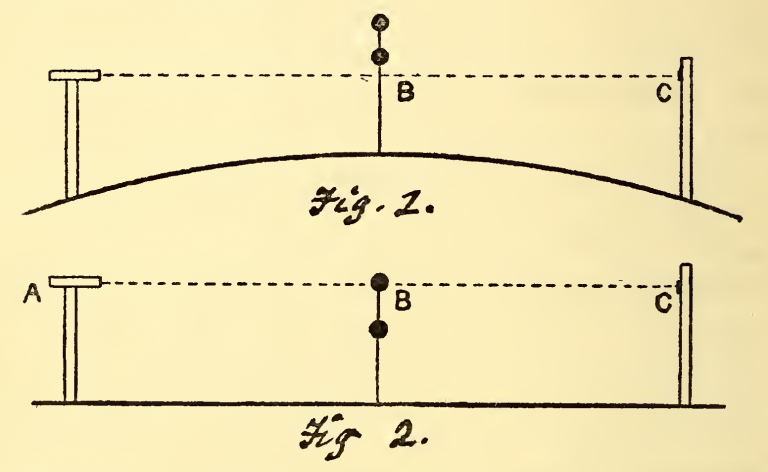
In the illustration above, the top picture is what would happen if the Earth’s surface is curved and the bottom if it is flat. The experiment was approved by all the involved parties, including Hampden and the referees.
When the experiment was in progress, Wallace was always accompanied by Hampden or the referee, and he made sure the height of all three objects was the same.
When seen through the telescope, the bridge and the pole in the middle appeared like this:
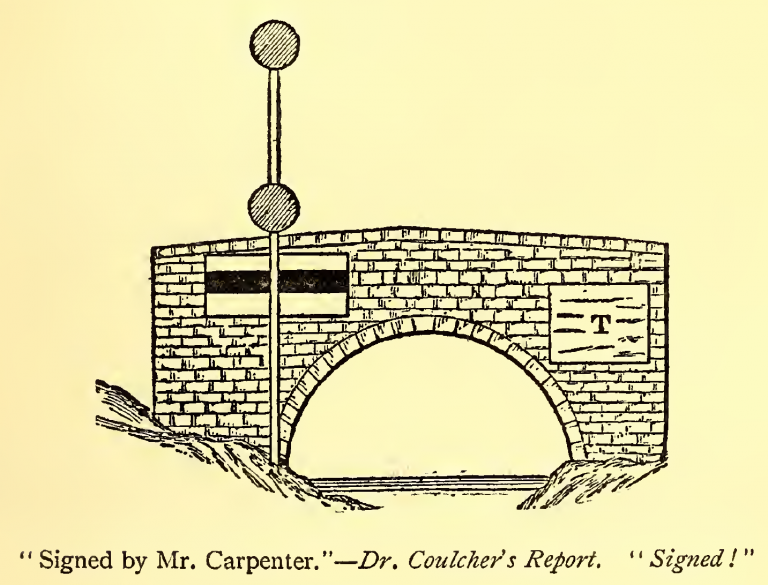
It is clear that both discs were seen above the black band, and Wallace’s hypothesis was correct. Unfortunately, Hampden did not take the result nicely. He argued that the telescope was not flat and did not have cross-hair. It was undoubtedly a made-up excuse and had absolutely no relevance to the experiment.
Wallace did follow his request, though, and borrowed a level and a telescope from his friend. In the second observation, the result, as it should be, appeared the same.
Wallace also did his experiment in the opposite direction. He put a flag on the Welney bridge and moved the telescope to the Old Bedford bridge. The result was also the same: both discs were visible above the flag.
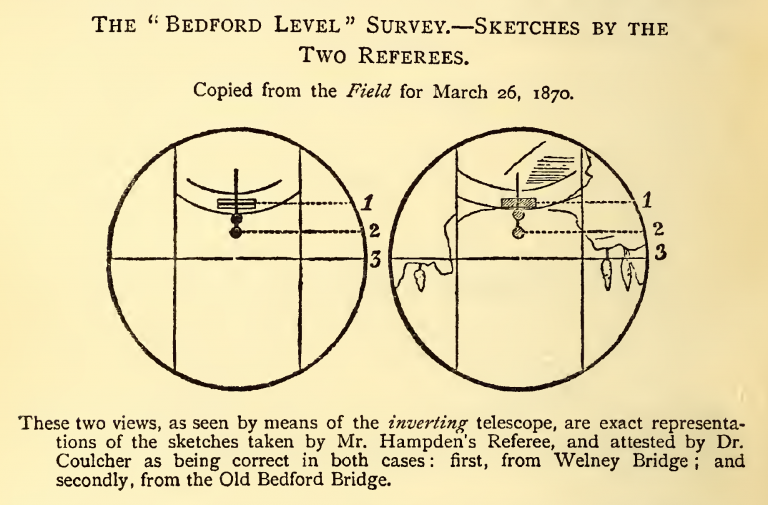
All the observations indicated both of the discs were seen above the black band (and the flag), so it was concluded that the water has curvature, as seen below.
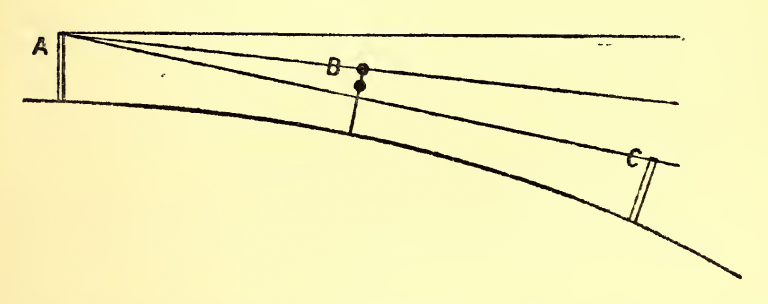
Wallace designed the experiment in a one-sided fashion, giving an advantage to Hampden. He did this by making the second disc below the top disc to ensure Hampden accepted the experiment.
All the referees and the representatives of Hampden agreed that Wallace had won the challenge. But the story did not end here. Hampden demanded Wallace return his money!
At that time, the money was still in the hands of a referee and had not been handed to Wallace. Unfortunately, the court ruled that the money was still in Hampden’s right because it had not been delivered to Wallace, probably because no written agreement was enforceable in the eye of the law.
And it was very far from over. Over the next 16 years, Hampden repeatedly threatened Wallace and the people involved in the competition, including one of the referees.
Hampden sent letters to people who knew Wallace and accused Wallace of being a liar. Wallace’s wife also received threats of murder. For this offense, Hampden was imprisoned for three months. But once free, he returned to his behavior again.
After that, Hampden committed various offenses that led him to get involved with the law numerous times:
- In 1871, one referee of the challenge sued Hampden for defamation. Hampden was sentenced to 1 year in prison.
- In January 1871, Wallace sued Hampden for defamation. The court ruled Hampden had to pay Wallace £600. But Hampden had cleverly transferred all his assets to his son-in-law so that he had no assets. For this, Wallace ended up having to pay the court fees.
- In October 1872, Wallace sued Hampden for defamation once more. The court let him go because Hampden published an apology in several newspapers.
- In January 1872, Hampden again committed defamation and was ‘forced to publish an apology through several newspapers.
- But only a few months later, Hampden was back in the defamation business, and he was sentenced to prison for two months.
- In March 1875, Hampden was again imprisoned for defamation charges for one year and two years, living under surveillance. But Hampden was released after only six months in prison.
- In January 1876, Hampden filed a lawsuit against Walsh, one of the referees, to regain the £500 challenge prize. But since Wallace had a debt of £687 due to previous charges, Wallace tried to pay the debt using the receivables. Hampden cleverly made himself bankrupt and transferred all of his assets to his son-in-law. In the end, Wallace paid the entire court fee of £277, not counting other costs.
- In 1878, once again, Hampden sent letters to Wallace’s colleagues.
- In 1885, Hampden sent a letter to Huxley, the president of the Royal Society, to defame Wallace.
Wallace thought he would get an easy £500, and the experiment was merely a matter of science. It was far from it; Wallace needed to spend plenty of time and money to deal with the Hampden problem.
References
- Old Bedford Level – Flat Earth Insanity
- Alfred Russel Wallace – Wikipedia
- My Life: A Record of Events and Opinions – Alfred Russel Wallace
- Eccentric Lives and Peculiar Notions – John F. Michell
- A Historic Experiment Shows Why We Might Not Want to Debate Fanatics – Gizmodo
- Wallace’s Woeful Wager: How a Founder of Modern Biology Got Suckered by Flat-Earthers – Scientific American
- The Experimental Demonstration of the Curvature of Earth’s Surface – H. Yule Oldham
- Result of Simulation


